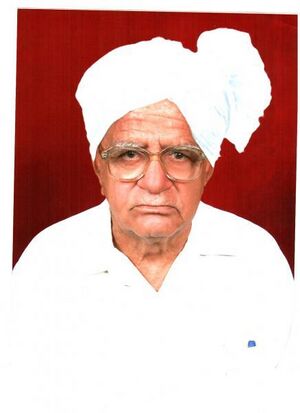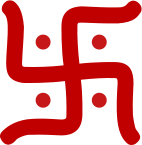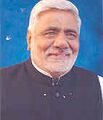Kadiyan

Kadiyan (X , not used) or Kadian (कादियान)[1] [2] or Kadyan (काद्यान, कादयान)[3] Kadiyaan Kadu (कादु) [4]gotra Jats are found in Haryana, Uttar Pradesh, Madhya Pradesh and Pakistan. They were supporters of Saroya Confederacy. [5]
There is chobisi (24 village) of Kadyan's in Haryana. Kadyan's are descendants of ancestor Kada,[6] which in Persian language means powerful. Sangu, Jakhu and Kada were in relation and they are said to have given names to Sangwan, Jakhar and Kadyan Jat gotras.[7] That's why many years back there existed no matrimonial relationship among these three gotras.
Origin
- They are probably descendants of rishi Kaundinya, a contemporary of Gautama, the Buddha.
- They are said to have descended from Kadru of Mahabharata. (Mbt:I.59.40)
- Kada , a Saroha Kshatriya, is said to have given name to Kadyan Jat gotra.[8]
History
Arrian[9] writes .....On the third day after the battle, Alexander reached the river Ister, which is the largest of all the rivers in Europe, traverses a very great tract of country, and separates very warlike nations. Of these nations the remotest are the Quadi.
Quadi were a Suebian Germanic tribe who lived approximately in the area of modern Moravia, a historical country in the Czech Republic (forming its eastern part), in the time of the Roman Empire. The only known information about the Germanic tribe the Romans called the 'Quadi' comes through reports of the Romans themselves, whose empire had its border on the River Danube just to the south of the Quadi. They associated the Quadi with their neighbours the Marcomanni, and described both groups as having entered the region after the Celtic Boii had left it deserted. The Quadi are thought to have been an important part of the Suebian group who crossed the Rhine with the Vandals and Alans in the 406 Crossing of the Rhine, and later founded a kingdom in northwestern Iberia.
Hukum Singh Panwar (Pauria)[10] considers Suevi to be the Shivi or Sibia Jat clans, who migrated from Sapta Sindhu.
There is strong need to research relation of Quadi tribe with Kadiyan clan.
A.Cunningham[11] gives details of Inscriptions on Rails— S. W. Quadrant in Bharhut Stupa established during Ashoka's rule reads as under:
- Pātaliputa Kodiyāniya Sakaja Devāyā dānam.
Cunningham has translated it as under:
- " Gift of Sakaja Deva, of the race of Kaundinya of Pataliputra."
A.Cunningham[12] further describes and translates one more Inscriptions on Rails— S. W. Quadrant in Bharhut Stupa established during Ashoka's rule as under:
- 56. Kadāya Yakhiya dānam. = "Gift of Kada Yakshi."
Kodiyāniya and Kada both refer to the Kadiyan clan.
They are mentioned by Cunningham[13] in an inscription at the Buddhist Stupa of Sanchi of the Ashoka period as under:
- No. 6. — Kādasa-bhichhuno- dānam.

Bhim Singh Dahiya[14] writes that J.F. Fleet, referring to the inscriptions on the top of a lid of the steatite casket found in stupa No.2 at Andheri, near Sanchi,[15] says that it should be, plainly read.
- Sapurisasa Gotiputasa Kakanada-Pabhasanasa Kodina-Gotasa.
This has been translated by Fleet as,
- "The relics of the virtuous Prabhasana of Kakanada, the Gotiputra, of the Kaundinya gotra".
Here no explanation has been given for the word 'Gotiputra'. It is similar to the word 'Rajaputra' occurring in the Kura inscriptions of Toramana, and it can only mean the son of a Jat. The gotra itself which Fleet changes into Kaundinya, may well be Kadin, the modern Kadian. [16]
Bhim Singh Dahiya [17] further writes about Kadyan gotra: We have already quoted inscriptional evidence mentioning a Kadan who is also called "Goti-Putra". Ancient coins have also been found with the legend 'Kāḍasa' in early Brahmi characters. Kadasa (Sanskrit Kāḍasya) means "(the coins of the Kāḍas". According to John Allan, these coins have not yet been attributed. [18] It has been suggested that the name Kāḍa may be for Sanskrit Kala. Cunningham says that Kāḍa may be equated with Kadrava, the descendant of Kadru. [19] Both these suggestions are untenable and these coins really belong to the Kādān or as it is now written, Kadyan clan. The original name is Kaḍā which means high in Persian language and the suffix 'an' is added to it. The places like Kādyān near Amritsar and another place Kadān in Balochistan is named after them. As John Allan states, the name is a tribal name and not that of a ruler. The coins were found along with the coins of Kunindas and therefore, point to a Punjab provenance. They belonged to the third century B.C. or early second century B.C. The standing figure on the coins holds a spear or sceptre in the left hand. The symbols on the coins are those of the Sun, the Swastika, etc.
Kadian (कादियान) tribe of Jats is found in Karnal. It has its head-quarters at Siwa and its original home was near Beri in Rohtak. [20]
According to H.A. Rose [21]Jakhar (जाखड़) is a tribe of Jats, claiming (Chauhan or Udhi) descent. Jaku, their eponym, migrated from Bikaner to Jhajjar in Rohtak. A Raja of Dwarka had a bow which Jaku failed to bend, in spite of the promised reward. In shame he left his native land and settled in Bikaner. The legend clearly points to the loss of military status by the Jakhars. Of the same stock are the Sangwan, Piru, and Kadian Jats.
Ch.3 Alexander at the Danube and in the Country of the Getae
Arrian[22] writes .....On the third day after the battle, Alexander reached the river Ister, which is the largest of all the rivers in Europe, traverses a very great tract of country, and separates very warlike nations. Most of these belong to the Celtic race,[1] in whose territory the sources of the river take their rise. Of these nations the remotest are the Quadi[2] and Marcomanni[3]; then the lazygianns,[4] a branch of the Sauromatians[5]; then the Getae,[6] who hold the doctrine of immortality; then the main body of the Sauromatians; and, lastly, the Scythians,[7] whose land stretches as far as the outlets of the river, where through five mouths it discharges its water into the Euxine Sea.[8] Here Alexander found some ships of war which had come to him from Byzantium, through the Euxine Sea and up the river. Filling these with archers and heavy-armed troops, he sailed to the island to which the Triballians and Thracians had fled for refuge. He tried to force a landing; but the barbarians came to meet him at the brink of the river, where the ships were making the assault. But these were only few in number, and the army in them small. The shores of the island, also, were in most places too steep and precipitous for landing, and the current of the river alongside it, being, as it were, shut up into a narrow channel by the nearness of the banks, was rapid and exceedingly difficult to stem.
Alexander therefore led back his ships, and determined to cross the Ister and march against the Getae, who dwelt on the other side of that river; for he observed that many of them had collected on the bank of the river for the purpose of barring his way, if he should cross. There were of them about 4,000 cavalry and more than 10,000 infantry. At the same time a strong desire seized him to advance beyond the Ister. He therefore went on board the fleet himself. He also filled with hay the hides which served them as tent-coverings, and collected from the country around all the boats made from single trunks of trees. Of these there was a great abundance, because the people who dwell near the Ister use them for fishing in the river, sometimes also for journeying to each other for traffic up the river; and most of them carry on piracy with them. Having collected as many of these as he could, upon them he conveyed across as many of his soldiers as was possible in such a fashion. Those who crossed with Alexander amounted in number to 1,500 cavalry and 4,000 infantry.
Footnotes:
1. The classical writers have three names to denote this race:— Celts, Galatians, and Gauls. These names were originally, given to all the people of the North and West of Europe; and it was not till Caesar's time that the Romans made any distinction between Celts and Germans. The name of Celts was then confined to the people north of the Pyrenees and west of the Rhine. Cf. Ammianus (xv. 9); Herodotus (iv. 49); Livy (v. 33, 34); Polybius (iii. 39).
2. Arrian is here speaking, not of Alexander's time, but of his own, the second century of the Christian era. The Quadi were a race dwelling in the south-east of Germany. They are generally mentioned with the Marcomanni, and were formidable enemies of the Romans, especially in the reign of Marcus Aurelius, when Arrian wrote. This nation disappears from history about the end of the fourth century.
3. The Marcomanni, like the Quadi, were a powerful branch of the Suevic race, originally dwelling in the south-wesb of Germany; but in the reign of Tiberius they dispossessed the Boii of the country now called Bohemia. In conjunction with the Quadi, they were very formidable to the Romans until Commodus purchased peace from them. The name denotes "border men." Cf. Caesar (Bel. Gal., i. 51).
4. The lazygians were a tribe of Sarmatians, who migrated from the coast of the Black Sea, between the Dnieper and the Sea of Azov, in the reign of Claudius, and settled in Dacia, near the Quadi, with whom they formed a close alliance. They were conquered by the Goths in the fifth century. Cf. Ovid (Tristia, ii. 191).
5. Called also Sarmatians. Herodotus (iv. 21) says that these people lived east of the Don, and were allied to the Scythians. Subsequent writers understood by Sarmatia the east part of Poland, the south of Russia, and the country southward as far as the Danube.
6. These people were called Dacians by the Romans. They were Thracians, and are said by Herodotus and Thucydides to have lived south of the Danube, near its mouths. They subsequently migrated north of this river, and were driven further west by the Sarmatians. They were very formidable to the Romans in the reigns of Augustus and Domitian. Dacia was conquered by Trajan ; but ultimately abandoned by Aurelian, who made the Danube the boundary of the Roman Empire. About the Getae holding the doctrine of immortality, see Herodotus (iv. 94). Cf. Horace (Carm., iii. 6, 13; Sat., ii. 6, 53).
7. The Scythians are said by Herodotus to have inhabited the south of Russia. His supposition that they came from Asia is doubtless correct. He gives ample information about this race in the fourth book of his History.
8. Herodotus (iv. 47) says the Danube had five mouths; but Strabo (vii. 3) says there were seven. At the present time it has only three mouths. The Greeks called the Black Sea πόντος εύξεινος, the sea kind to strangers. Cf. Ovid (Tristia, iv. 4, 55):—"Frigida me cohibent Euxini litora Ponti, Dictus ab antiquis Axenus ille fuit."
काद्यान गोत्र का इतिहास
पंडित अमीचन्द्र शर्मा[23]ने लिखा है: काद्यान गोत्र के जाटों का बड़ा कादा था। कादा भी सरोहा क्षत्रिय था। सरोहा संघ मुख्यत: जाट गोत्रों से ही बना था। वह सांगू का सहोदर भाई था। कादे को कादू भी कहते थे। कादू भी अपने भाई सांगू के साथ ही अजमेर से आया था और जिला रोहतक में बस गया। कादू भी जाट संघ में सामिल हो गया। उसने करेवा किया था। कादू के नाम पर काद्यान गोत्र जाट गोत्र प्रारम्भ हुआ। जिला रोहतक में इनके 12 गाँव हैं – बेरी , माजरा, दूबलधन आदि इनके मुख्य गाँव हैं।
Distribution in Haryana
Villages in Bhiwani district
Villages in Kaithal district
Villages in Faridabad district
Villages in Jhajjar district
Baghpur, Beri, Beyoli, Cheemni, Daadyan, Dharanna, Dhaur, Dubaldhan, Dubaldhan Majra, Madana, Mangawas, Siwana, Bir Sunarwala,
Villages in Jind district
Villages in Panipat district
Sivah, Bajana, Jatol Panipat, Nangal Kheri, Garhi Sivah,
Villages in Rohtak district
Chhuanna, Garhi Ballab, Mokhara,
Villages in Yamuna Nagar district
Distribution in Uttar Pradesh
Villages in Muzaffarnagar district
Bhainswal, Chhachharauli, Johra, Mustafabad, Muzaffarnagar, Nagla Mubarik, Nai Nangla, Pachenda Kala, Pachainda Khurd, Usmanpur,
Villages in Saharanpur district
Distribution in Uttaranchal
Villages in Haridwar district
Distribution in Delhi
Distribution in Rajasthan
KADYAN FARM HOUSE,VILLAGE-PIPALI, DISTT-JHUNJHUNU (RAJASTHAN) Shanti Nagar (Jaipur),
Villages in Hanumangarh district
Distribution in Madhya Pradesh
Bhopal, Khadawda (Nimach), Ratlam 1,
Villages in Ratlam district
Villages in Ratlam district with population of Kadiyan (काडीयान) gotra are:
Ratlam 4,
Villages in Gwalior district
Villages in Shivpuri district
Villages in Bhopal district
Distribution in Punjab
Villages in Jalandhar district
Villages in Ludhiana district
- Kadiyan is village in Ludhiana West Tahsil in Ludhiana district, Punjab.
Distribution in Pakistan
Qadianis tribe found in Badin district in Sindh province of Pakistan.
Notable persons
- Sunil Kadian and Joginder Kadian - Haryana Police ,
- Prof Sher Singh - Ex Deputy Chief Minister of Punjab in the Fifties.
- Late Ch. Pratap Singh Daulta - MLA, MP, Advocate.
- Dr. Raghuvir Singh Kadian - Former speaker of Haryana Vidhan Sabha.
- Lt Gen RS Kadian - From village Dubaldhan Majra (दूबलधन माजरा).
- Ch. Banwari Lal Kadiyan - Retd. CSO R/o Pipali (JhunJhunu).
- Mohinder Singh Kadian - Tehsildar (Retd.).
- Chhatar Singh Kadyan - Pradhan Kadyan Khap, Dubaldhan.
- Major Mahinder Singh Kadiyan -
- Pamella Bordes -
- Haridev Kadyan - Rowing.
- Ravi kadian - Rowing.
- Naresh Kadyan - Renowned Animal Rights Activist.
- Dr. Om Parkash Kadyan - Retired B.D.O - At present Editer & Yoga / Naturecure centre.
- Dr. Sudhir Kadian - prominent doctor.
- Dr. Rajeshwar Singh Kadian - prominent doctor
- Sanwal Singh Kadyan - Socialist from Dubaldhan & Ex President of Kadyan khap.
- Rt. SP. Jile Singh Kadyan - Retired Superintendent of Police from Village - Dharana.
- Abhishek Kadyan - Hon. Animal Welfare Officer, AWBI (Ministry of Environment and Forest - Govt. of India) / Member, District Public Relation and Grievances Committee (Govt. of Haryana) / Media Adviser to United Nations affiliated OIPA in India - PFA Haryana.
- Mrs. Suman Malik Kadyan, Manager Retail and Rep. of OIPA at Toronto in Canada.
- Satbir Kadyan - Former Speaker, Haryana Vidhan Sabha.
- Lt. Col. Rajan Kadyan - ASC Core.
- L. D. Shri Purjit Singh Kadian - Won 7 Medals in 2nd World war (BERI).
- Narender Kadyan - Tehsildar.
- Lt. Col. Rizak Ram Kadyan - Jag Branch.
- Mukesh Kadyan - Social Service.
- Ram Phal Kadyan - DSP, Ganour.
- Sharda Kadyan - Animal Rights Activist.
- Sukanya Kadyan Berwal- Hon. Animal Welfare Officer, AWBI (Ministry of Environment and Forest - Govt. of India) / Member, District Public Relation and Grievances Committee (Govt. of Haryana) / Programme Director to United Nations affiliated OIPA in India.
- Satnarayan Kadyan - Secretary to Speaker ,Haryana Vidhan Sabha.
- Ajay Kumar Kadian - IFS, Haryana, 1987.
- Rajesh Kadyan - IRS ,Delhi.
- Krishna Kadyan - Constituted Jat Sabha ,Andhra Pradesh.A Resident of Dubaldhan ,Rohtak.
- Lt Col Rajeev Singh Kadian - Beri ,(Nirachia) Aoc Officer.
- Sumitra Kadyan - Haryana Judicial Services (Jat Jyoti:4/2013)

- Sombir Singh Kadyan (Naib Subedar) (04.02.1982 - 24.02.2019), Shaurya Chakra (posthumous), became martyr of militancy on 24.02.2019 at Kulgam in Jammu and Kashmir. He was from Mithi village in Siwani tahsil of Bhiwani district in Haryana. Unit: 8 Jat Regiment/34 Rashtriya Rifles.
- Bale Ram Kadian - Freedom Fighter Jem.Bale Ram Kadian VPO Beri, Distt Jhajjar
- Abhijeet Kadian: IPS-2012, ASP HQ Jhargram, WB Cadre, Husband of Savita Dahiya, IFS, M: 8902466267
- Viren Kadyan: Civil Judge cum JMIC Sirsa, Native Dubaldhan Majra, Jhajjar, M: 9466866822
- Virendra Kadyan: IRTS 2011 batch, Posted Bilaspur, Chhattisgarh, M: 8010242052
- Pawan Kadyan: IAS (CSE-2011), Rank 79, Cadre West Bengal, From: Haryana
- Vicky Kadian - Film Actor
- Roopali Kadyan - Bollywood Film Producer
- Capt. Dilbag Singh Kadian Of 4 Jat BN, Fought 1971 India-Pak War, Sena Medal Awardee.
- Devender Kadyan - Businessman and Politician
Gallery
-
Dilbag Singh Kadian[24]
-
काद्याण खाप का एक फैसला
-
प्रताप सिंह दौलता
-
प्रोफेसर शेर सिंह
-
डा. रघुवीर सिंह काद्याण
-
ले. जनरल राज सिंह काद्याण
References
- ↑ Jat History Dalip Singh Ahlawat/Parishisht-I, s.n. क-51
- ↑ Dr Ompal Singh Tugania: Jat Samuday ke Pramukh Adhar Bindu, p.31,sn-274.
- ↑ B S Dahiya:Jats the Ancient Rulers (A clan study), p.239, s.n.103
- ↑ Dr Ompal Singh Tugania: Jat Samuday ke Pramukh Adhar Bindu, p.31,sn-274.
- ↑ Jat Varna Mimansa (1910) by Pandit Amichandra Sharma,p. 57
- ↑ Mahendra Singh Arya et al.: Adhunik Jat Itihas, Agra 1998, p. 229
- ↑ Jat Varna Mimansa (1910): Pandit Amichandra Sharma, Published by Lala Devidayaluji Khajanchi, pp.21-24
- ↑ Jat Varna Mimansa (1910): Pandit Amichandra Sharma, Published by Lala Devidayaluji Khajanchi, p.23
- ↑ Arrian Anabasis Book/1a, ch.3
- ↑ The Jats:Their Origin, Antiquity and Migrations/An Historico-Somatometrical study bearing on the origin of the Jats, pp.159-160
- ↑ The stūpa of Bharhut,p. 139
- ↑ The stūpa of Bharhut,p. 142
- ↑ The Bhilsa topes: Inscriptions, P. 235
- ↑ Jats the Ancient Rulers (A clan study)/The Empire of the Dharan Jats, Misnamed Guptas,p.187
- ↑ Bhilsa Tope, p. 347; and Plate XXIX, No.7
- ↑ CII, Vol. III, p. 31.
- ↑ Jats the Ancient Rulers (A clan study)/Appendices/Appendix III, pp.337-38
- ↑ Catalogue of the coins of ancient India, Orient Reprint, 1975, SS 103.
- ↑ ASIAR, Vol. II, p. 10,
- ↑ A glossary of the Tribes and Castes of the Punjab and North-West Frontier Province By H.A. Rose Vol II/K,p.420
- ↑ A glossary of the Tribes and Castes of the Punjab and North-West Frontier Province By H.A. Rose Vol II/J,p.349-50
- ↑ Arrian Anabasis Book/1a, ch.3
- ↑ Jat Varna Mimansa (1910), Author: Pandit Amichandra Sharma, Published by Lala Devidayaluji Khajanchi, pp.21-22
- ↑ https://www.facebook.com/JattRegimentOfficial/
Back to Jat Gotras
- Jat Gotras
- Gotras after Persons
- Muslim Jat Gotras
- Jat Gotras in Pakistan
- Madhya Pradesh
- Haryana
- Rajasthan
- Punjab
- Uttar Pradesh
- Gotras in Jaipur
- Gotras in Bhopal
- Gotras in Bhiwani
- Gotras in Faridabad
- Gotras in Jind
- Gotras in Jhajjar
- Gotras in Panipat
- Gotras in Rohtak
- Gotras in Yamunanagar
- Gotras in Nimach
- Gotras in Ratlam
- Gotras in Gwalior
- Gotras in Shivpuri
- Gotras in Muzaffarnagar
- Gotras in Jalandhar
- Villages in Jalandhar
- Villages in Ludhiana
- Gotras in Ludhiana
- Gotras in Badin
- Saroya History
- Jat History


![Dilbag Singh Kadian[24]](/w/thumb.php?f=Dilbag_Singh_Kadian.jpg&width=120)




